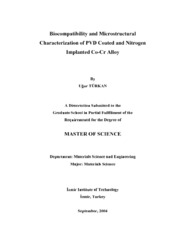Please use this identifier to cite or link to this item:
https://hdl.handle.net/11147/3248| Title: | Biocompatibility and Microstructural Characterization of Pvd Coated and Nitrogen Implanted Co-Cr Alloy | Authors: | Türkan, Uğur | Advisors: | Öztürk, Orhan | Keywords: | Ion implantation Immersion test |
Publisher: | Izmir Institute of Technology | Abstract: | In this study, the effectiveness of nitrogen ion implanted and TiN coated layers on CoCrMo alloy (ISO 5832-12) in preventing metal ion release during in vitro exposure of these layers to simulated body fluid (SBF) was investigated. The experimental results clearly show higher levels of cobalt ion release from nitrogen implanted CoCrMo material surfaces into simulated body fluid as compared to the as-polished CoCrMo alloy. The results clearly indicate that nitrogen ion implantation used for modification of fcc CoCrMo alloy surfaces lead to the development of various near surface microstructures. Nitrogen ion implantation was carried out at 60 and 30 keV ion energies with the corresponding current densities of 0.1 and 0.2 mA/cm2, respectively, for the substrate temperatures of 100, 200 and 400 °C and implantation time of 30 minutes. Near surface crystal structures and phases, nitrogen ion implanted and TiN coated layer thicknesses were characterized by a combination of symmetric (.-2.) and grazing incidence x-ray diffraction (XRD and GIXRD) and cross-sectional scanning electron microscopy (SEM). Metal ion release into the simulated body fluid was analyzed by atomic absorption spectrometry (AAS) and inductively coupled plasma optical emission spectrometry (ICP-OES). The experimental XRD results clearly show the formation of a metastable, fcc, high-N phase (.N) in mainly fcc CoCrMo alloy for the ion beam conditions at 400 °C. The lower implantation temperatures, 100 and 200 °C, for both 60 and 30 keV ion energies, result in a nitride phase, (Co, Cr, Mo)2+xN. The cross sectional SEM results for the specimens implanted at the 60 and 30 keV ion energies at 400 °C reveal quite clearly the uniform nature of the .N layers. The .N layer thicknesses, based on the SEM data, were found to be 450 and 540 nm for the 60 and 30 keV implanted specimens, while the (Co, Cr, Mo)2+xN nitride layer has a thickness range from 150 to 250 nm for the 60 and 30 keV at 100 and 200 °C implantation conditions. The SEM results also indicate that the (Co, Cr, Mo)2+xN nitride and .N phase layers on the CoCrMo alloys have high etch resistance suggesting enhanced corrosion resistance for the N implanted specimens compared to the substrate material. The XRD and SEM results for the TiN coated (via PVD) specimens show that the fcc TiN coatings exhibit (111) preferred orientation and have a coating thickness of . 3 µm with a columnar type of growth mode. The experimental AAS results show that in vitro exposure of the N implanted layers result in higher levels of cobalt ion release into the SBF than the as-polished substrate CoCrMo alloy. This was attributed to the rougher surfaces of the N implanted specimens compared to that of the substrate material (i.e, rougher surface implying a larger area is available for metal ion release). It was also found that the specimens implanted at the lower substrate temperatures of 100 and 200 °C have lower levels of Co ion release compared to those specimens implanted at the substrate temperature of 400 °C. The limited dissolution of cobalt, in this case, was explained by the stronger bonds of metal-N in the nitride phase than those of .N phase. Furthermore, the AAS data indicate higher cobalt ion release rate for the N implanted specimens compared to the substrate alloy and suggest transport (diffusion) controlled dissolution reaction mechanism. The AAS results show no cobalt ions are released from the TiN coated specimens (i.e, the release levels were below the analytical detection limit of the AAS apparatus). This indicates that the TiN coated layer can be an effective barrier for reducing the metal ion release from the substrate alloy. The SEM/EDX study of the surface morphologies of the N implanted, TiN coated and as-polished CoCrMo alloy test specimens after the static immersion test clearly indicate calcium phosphate formation on the as-polished alloy, while there was almost no phosphate precipitates on the surface of N implanted and TiN coated specimens. While the experimental results show higher levels of cobalt ion release for the N implanted specimens compared to the substrate material, the overall release levels are found to be below toxic levels for the human body. | Description: | Thesis (Master)--Izmir Institute of Technology, Materials Science and Engineering, Izmir, 2004 Includes bibliographical references (leaves: 80-83) Text in English; Abstract: Turkish and English xiii, 87 leaves |
URI: | http://hdl.handle.net/11147/3248 |
| Appears in Collections: | Master Degree / Yüksek Lisans Tezleri |
Files in This Item:
| File | Description | Size | Format | |
|---|---|---|---|---|
| T000437.pdf | MasterThesis | 9.04 MB | Adobe PDF |  View/Open |
CORE Recommender
Page view(s)
228
checked on Apr 14, 2025
Download(s)
132
checked on Apr 14, 2025
Google ScholarTM
Check
Items in GCRIS Repository are protected by copyright, with all rights reserved, unless otherwise indicated.